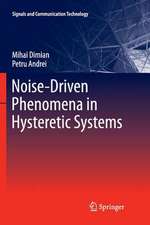Automatic Speech Recognition: A Deep Learning Approach: Signals and Communication Technology
Autor Dong Yu, Li Dengen Limba Engleză Hardback – 28 noi 2014
| Toate formatele și edițiile | Preț | Express |
|---|---|---|
| Paperback (1) | 946.87 lei 6-8 săpt. | |
| SPRINGER LONDON – 10 sep 2016 | 946.87 lei 6-8 săpt. | |
| Hardback (1) | 953.03 lei 6-8 săpt. | |
| SPRINGER LONDON – 28 noi 2014 | 953.03 lei 6-8 săpt. |
Din seria Signals and Communication Technology
- 18%
 Preț: 952.89 lei
Preț: 952.89 lei - 18%
 Preț: 1559.80 lei
Preț: 1559.80 lei - 17%
 Preț: 361.80 lei
Preț: 361.80 lei - 18%
 Preț: 811.61 lei
Preț: 811.61 lei - 15%
 Preț: 585.26 lei
Preț: 585.26 lei - 18%
 Preț: 727.97 lei
Preț: 727.97 lei - 15%
 Preț: 585.90 lei
Preț: 585.90 lei -
 Preț: 393.35 lei
Preț: 393.35 lei - 20%
 Preț: 1002.73 lei
Preț: 1002.73 lei - 15%
 Preț: 641.71 lei
Preț: 641.71 lei - 20%
 Preț: 338.92 lei
Preț: 338.92 lei - 18%
 Preț: 1579.66 lei
Preț: 1579.66 lei - 18%
 Preț: 896.08 lei
Preț: 896.08 lei - 18%
 Preț: 847.11 lei
Preț: 847.11 lei - 18%
 Preț: 1234.77 lei
Preț: 1234.77 lei - 18%
 Preț: 905.54 lei
Preț: 905.54 lei - 15%
 Preț: 646.43 lei
Preț: 646.43 lei - 20%
 Preț: 662.48 lei
Preț: 662.48 lei - 15%
 Preț: 641.20 lei
Preț: 641.20 lei - 18%
 Preț: 1847.84 lei
Preț: 1847.84 lei - 18%
 Preț: 946.24 lei
Preț: 946.24 lei - 18%
 Preț: 1241.10 lei
Preț: 1241.10 lei - 20%
 Preț: 649.43 lei
Preț: 649.43 lei - 20%
 Preț: 993.28 lei
Preț: 993.28 lei - 18%
 Preț: 940.57 lei
Preț: 940.57 lei - 18%
 Preț: 1389.30 lei
Preț: 1389.30 lei - 20%
 Preț: 1003.50 lei
Preț: 1003.50 lei - 18%
 Preț: 953.52 lei
Preț: 953.52 lei - 20%
 Preț: 1001.16 lei
Preț: 1001.16 lei - 18%
 Preț: 1415.36 lei
Preț: 1415.36 lei - 15%
 Preț: 653.33 lei
Preț: 653.33 lei - 15%
 Preț: 645.60 lei
Preț: 645.60 lei - 15%
 Preț: 637.28 lei
Preț: 637.28 lei - 18%
 Preț: 948.79 lei
Preț: 948.79 lei - 18%
 Preț: 945.62 lei
Preț: 945.62 lei - 18%
 Preț: 836.36 lei
Preț: 836.36 lei - 18%
 Preț: 1225.46 lei
Preț: 1225.46 lei - 15%
 Preț: 635.01 lei
Preț: 635.01 lei - 15%
 Preț: 639.25 lei
Preț: 639.25 lei - 15%
 Preț: 646.30 lei
Preț: 646.30 lei - 15%
 Preț: 639.25 lei
Preț: 639.25 lei - 15%
 Preț: 712.36 lei
Preț: 712.36 lei - 20%
 Preț: 1006.12 lei
Preț: 1006.12 lei - 18%
 Preț: 970.56 lei
Preț: 970.56 lei
Preț: 953.03 lei
Preț vechi: 1162.23 lei
-18% Nou
Puncte Express: 1430
Preț estimativ în valută:
182.37€ • 195.01$ • 152.05£
182.37€ • 195.01$ • 152.05£
Carte tipărită la comandă
Livrare economică 18 aprilie-02 mai
Preluare comenzi: 021 569.72.76
Specificații
ISBN-13: 9781447157786
ISBN-10: 1447157788
Pagini: 348
Ilustrații: XXVI, 321 p. 62 illus.
Dimensiuni: 155 x 235 x 30 mm
Greutate: 0.66 kg
Ediția:2015
Editura: SPRINGER LONDON
Colecția Springer
Seria Signals and Communication Technology
Locul publicării:London, United Kingdom
ISBN-10: 1447157788
Pagini: 348
Ilustrații: XXVI, 321 p. 62 illus.
Dimensiuni: 155 x 235 x 30 mm
Greutate: 0.66 kg
Ediția:2015
Editura: SPRINGER LONDON
Colecția Springer
Seria Signals and Communication Technology
Locul publicării:London, United Kingdom
Public țintă
ResearchCuprins
Section 1: Automatic speech recognition: Background.- Feature extraction: basic frontend.- Acoustic model: Gaussian mixture hidden Markov model.- Language model: stochastic N-gram.- Historical reviews of speech recognition research: 1st, 2nd, 3rd, 3.5th, and 4th generations.- Section 2: Advanced feature extraction and transformation.- Unsupervised feature extraction.- Discriminative feature transformation.- Section 3: Advanced acoustic modeling.- Conditional random field (CRF) and hidden conditional random field (HCRF).- Deep-Structured CRF.- Semi-Markov conditional random field.- Deep stacking models.- Deep neural network – hidden Markov hybrid model.- Section 4: Advanced language modeling.- Discriminative Language model.- Log-linear language model.- Neural network language model.
Recenzii
“Deep Learning (DL) has demonstrated a phenomenal success in various AI applications. … This book by two leading experts in Deep Learning is certainly a welcome addition to the literature of the field, particularly in automatic speech recognition. … this book presents a very valuable vista of the state-of-art of Deep Learning, focusing on speech recognition applications.” (Robert Kozma, Mathematical Reviews, September, 2017)
Textul de pe ultima copertă
This book provides a comprehensive overview of the recent advancement in the field of automatic speech recognition with a focus on deep learning models including deep neural networks and many of their variants. This is the first automatic speech recognition book dedicated to the deep learning approach. In addition to the rigorous mathematical treatment of the subject, the book also presents insights and theoretical foundation of a series of highly successful deep learning models.
Caracteristici
Presents important theoretical foundation and practical considerations of using a wide range of deep learning models and methods for automatic speech recognition Reviews past and present work (up to the fall of year 2014) on most impactful work based on deep learning for acoustic modeling in speech recognition Goes deeply into rigorous mathematical and technical descriptions of deep learning methods successful for speech recognition and related areas of applications Analyzes research directions and trends towards establishing future-generation speech recognition based on extending the current deep learning models Includes supplementary material: sn.pub/extras



























